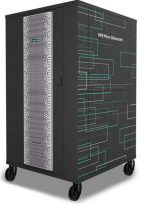How COVID-19 Has Impacted Tech Earnings

As earnings reports roll in for public companies worldwide, the curtain has been pulled back on the effect of the COVID-19 pandemic on the tech sector, revealing the near-term impact on cloud providers and their suppliers.
The Wall Street version: The public cloud leaders have shown good results, albeit with a few shortfalls. Telecom operators are shape-shifting in response to demand for broadband services to support remote work. Enterprises are pivoting on digital transformation plans. And closure of plants and offices in key areas such as California, Mexico, and Asia have caused delays for major equipment suppliers.
The bottom line is that it was confusing earnings season that offers little visibility ahead. Let’s look at some of the details.
Cloud Providers Rise to the Top
If there are any winners in the current tech economy, Amazon (Nasdaq: AMZN), Microsoft (Nasdaq: MSFT), and Alphabet/Google (Nasdaq: GOOGL) fit the bill. For the first quarter, all reported solid earnings, albeit with a few holes. Amazon’s AWS sales hit a new quarterly high; Microsoft’s revenues beat expectations; Google reported revenue growth, though earnings drooped a bit below expectations.
Still, analysts have concerns. In a recent note, Rohit Kulkarni, executive director at MKM Partners, stated that while revenues were way up for public clouds AWS, Azure, and Google Cloud (33%, 61%, and 52% respectively year-over-year), a hold on large enterprise projects, a slowdown in industries such as hospitality and travel, and cash shortfalls for small and medium-sized businesses (SMBs) are all taking bites out of revenue. Further, Kulkarni thinks cloud companies are increasing their bad debt allowances to accommodate business customers, particularly ones in the SMB range.
Vendors that rely heavily on supplying the private and public infrastructure are pulling back. VMware (NYSE: VMW), for example, has had to freeze salaries and pay, even though it laid off workers earlier this year.
Some vendors, including Hewlett-Packard Enterprise (NYSE: HPE), are extending financing plans to sustain enterprise revenue. According to Simon Leopold and colleagues at Raymond James, this approach could help suppliers that have good enough credit to extend financing terms at scale. But investors could be wary of the results.
Telecoms Regroup to Fit New Realities
But the loss of enterprise customers due to closure of businesses is pinching off any significant gains for most carriers, producing flat or slightly lower final results.
Still, large telecom companies are eyeing 5G and cloud infrastructure as the way to a better future. Some are looking for traction via M&A and joint ventures, such as T-Mobile’s acquisition of Sprint and the proposed US$38 billion merger of the U.K.’s second-largest mobile operator, O2, with the country’s largest cable company, Virgin Media.
OEMs Face Supply-Chain Bottlenecks
While telecom providers look to expand their networks, the major original equipment manufacturers (OEMs) face their own challenges.
“We are … experiencing supply chain constraints,” said Jayshree Ullal, CEO of Arista Networks (NYSE: ANET) on the vendor’s recent Q12020 earnings conference call. “[A]nd we are … coping with some inventory and component shortages. Lead times vary and have doubled recently for some of our popular products.” Since Arista is a big supplier to Microsoft and Facebook, its pipeline issues could affect those vendors’ expansion plans.
Juniper (NYSE: JNPR), another supplier to telcos, faces the same situation. “If not for challenges securing supply, we believe our Q1 revenue and non-GAAP EPS would have been between the mid and high end of our guidance range,” said Juniper CEO Rami Rahim on the earnings conference call. Instead, overall quarterly revenue was flat year-over-year, and revenue from service provider customers was down nearly 14%.
Still, Jefferies analysts George C. Notter and Kyle McNealy see Juniper, along with optical vendor Ciena (NYSE: CIEN), as potential beneficiaries of network expansions forced by the pandemic. In a recent note they state:
[W]e believe there are three areas of telco network investments getting driven by current bandwidth growth: 1) metro area networks; 2) broadband aggregation networks; and 3) peering/connectivity with Internet Content Providers. Ciena and Juniper are primary beneficiaries here.
Other vendors in line to possibly benefit are wireless vendors Nokia (NYSE: NOK) and Ericsson (Nasdaq: ERIC), along with Juniper competitor Cisco (Nasdaq: CSCO) and Fortinet (Nasdaq: FTNT).
Cloudy Outlook
No clear picture emerges from all this, but there are notable items: The major public clouds will continue to grow, though hampered by the slowdown in enterprise spending. Telecom suppliers will look to extend their wireless lead into 5G. And while all wait for the crisis to clear, they’ll hoard their cash and hedge their bets.





















